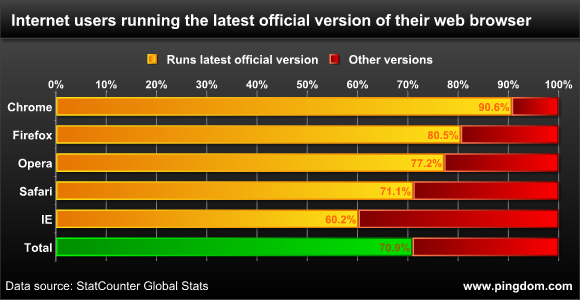
Web developers fight a constant struggle: They want to use modern web browser features, but they also need to take browser adoption into consideration. If a large portion of their users run older versions of browsers, web developers will be limited in what they can accomplish.
With this in mind, we decided to find out how many people are running the latest version of their browser, whether it be Internet Explorer, Firefox, Chrome, Safari or Opera.
The current situation
Before we go any further, we should point out that what we examine in this article is the situation right now. The numbers will vary a bit over time since they are dependent on new browser versions being launched, how long ago the latest versions have been on the market, etc.
To make sure the numbers are up-to-date, we based them on stats for the first four days of November. That should be a decent snapshot of the current situation. The data is from StatCounter, based on visitor stats from more than 3 million websites.

For the record, the latest official (major) versions right now are Internet Explorer 8.0, Firefox 3.6, Chrome 7.0, Safari 5.0 and Opera 10.6.
Summary:
- 91% of Chrome users run version 7.0.
- 81% of Firefox users run version 3.6.
- 77% of Opera users run version 10.6.
- 71% of Safari users run version 5.0.
- 60% of Internet Explorer users run version 8.0.
- The share of Internet users who are running the latest official, major version of either Internet Explorer, Firefox, Chrome, Safari or Opera is 71%.
It’s not strange that Chrome “wins” this since it’s currently the only browser with automated upgrades (they are handled in the background). It will most likely be a bit higher a few weeks from now since there’s still a small portion of version 6 users that haven’t upgraded yet. Another thing that brings down the number a bit are the various beta and developer versions.
Getting users to upgrade
Convincing users to upgrade their browsers can be a challenge, and browser developers have had varying levels of success with this. We studied this in detail a while back, and it’s still an interesting read if you’re curious to see how quickly various browsers tend to be upgraded.
We can’t help but think that webmasters can do their part here as well by educating their users when possible (and where appropriate, of course).
Final words
To be honest, the situation is better than we expected. To know that 71% of users are running the latest version of their browser is good news for web developers. It means that websites hoping to make use of the latest browser features have a pretty good user base to pick from.
The black sheep in the flock is Internet Explorer. Of the people running Internet Explorer, 25% are still running version 7, and 14% are still running version 6. Hopefully Microsoft will be able to convince most of those users to upgrade to version 9 once it becomes available.


























